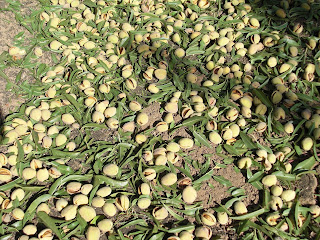A smoke-like cloud of dust billows skyward, rising from deep inside a stand of almond trees.
No, it’s not some unusual mid-summer twister emerging from the orchard. Rather it’s the sign of analmond tree shaker at work.
 |
| The first almond tree shaking is taking place in the Westside. |
From now until early fall, growers will be busy harvesting nuts. Starting off the harvest are the soft shell varieties such as nonpareil. The hard shell varieties such as padre and mission are shaken off the trees toward the later part of the season.
“We see shaking into October,” Jenna says. The harvest lasts into the fall for a couple reasons. First, growers plant different almond varieties in each orchard, meaning they will come back a couple times to knock off the nuts. Second, an area’s climate will impact the timing of harvest – usually the areas further east are a bit cooler and almond hull split occurs later than in the hotter locales.
 |
| It's important to pick up the almonds as soon as they dry. |
For growers still waiting to start shaking their trees, there are a lot of harvest preparations still ahead. University of California extension advisors advise growers to make a final check for ants on the orchard floor. Tackling ant infestations early can save 140 pounds of nuts, based on an average yield of 2,000 pounds per acre, according to a UC study.
While ant bait is the most effective,
it can take several weeks to get rid of a whole colony. If the harvest is about
two weeks away, then growers can apply a conventional spray. Jenna reminds
growers to continue monitoring for navel orangeworm and peachtwig borer as
well.
 |
| Growers will irrigate their orchards between shaking. |
The last pre-harvest irrigation
should be about two weeks before shaking. This will allow the soil to be dry
enough for the trees to withstand bark damage due to shaking. Farm advisors
point out that the type of soil will determine the time between irrigation and
shaking. Sand requires less time for drying while clay needs more time to dry.
Orchards with sandy
soils, which hold less water, may require irrigation between harvesting the
different varieties. Proper water management between varieties is important
because this is the time the trees develop the fruit buds for the next season,
UC IPM says.How do growers come up with the start time for harvest? The basic test is
striking a tree limb to see how many nuts fall off. Growers should test shake a
few trees. The entire orchard is ready once 99 percent of the nuts are shaken
from these test trees. Growers also look for any bark damage during the tests.
If there are signs of any damage, then they should wait a few days and test
again. Bark damage can open the way for diseases.
Mechanical shaking can be tried out when the interior section of the orchard
reaches full hull split. The best results for mature trees are when shaking is done
at 100 percent hull split.Meanwhile in the fields, our field scout Carlos Silva says growers are starting to harvest their alfalfa again. The pest on his watch list is the spotted alfalfa aphid, which can be more troublesome that the pea aphid. Counts are up for the spotted alfalfa aphid, but still short of the treatment threshold.
 |
| Spotted alfalfa aphid can be trouble. |
The cotton plants are continuing to develop nicely. “The plants are at 12 fruiting nodes. Retention is still good,” Carlos adds.
Are you looking to buy anarkali dress online shopping low price for girls and ladies. Huge collection of anarkali suits with waistcoat online available in different colours, patterns, designs & price ranges at aufashionkart.com.
ReplyDelete